Abstract
References
- 1. Adams, R. P. (2007). Identification of Essential Oil Components by Gas Chromatography/ Mass Spectrometry (4th ed.). Carol Stream, Illinois, IL: Allured Publishing. 2. Akharaiyi, F. C., Boboye, B. & Adetuyi, F. C. (2012). Antibacterial, phytochemicals and antioxidant activities of the leaf extracts of Gliricidia sepium and Spathodea campanulata. World Applied Sciences Journal 16(4), 523-530.
Evaluation of chemical profiles and biological properties of Gliricidia sepium (Jacq.) Walp. volatile oils from Nigeria
Abstract
Volatile oils obtained by hydrodistillation from Gliricidia sepium (Jacq.) Walp. leaf and stem were examined for their chemical composition and biological activity. The oils were analyzed by gas chromatographic-mass spectrometric (GC-MS) techniques. Toxicity, antimicrobial and antioxidant activities were evaluated via brine shrimp lethality assay, agar-diffusion, and DPPH radical-scavenging methods, respectively. A total of 43 and 44 constituents were identified in the leaf and stem oils, correspondingly. The major components recognized in the leaf oil were (E)-hexadecatrienal (16.9%) and pentadecanal (16.0%) while humulene epoxide II (17.5%) and caryophyllene oxide (10.6%) dominated the stem oil. There was no significant activity against the bacteria but moderate inhibition zones (IZ) between 1.8±0.3 and 8.1±0.1 mm were observed against the fungi. The stem oil showed better antifungal activity than the leaf oil but not as active as the standard drug ketoconazole which inhibited the test fungi with IZ range of 10.4±0.4-21.0±1.4 mm at 200 μg. Both oils were toxic to brine shrimp (Artemia salina) giving LC50 of 79.7 μg/mL (leaf) and 38.7 μg/mL (stem). The leaf and stem oils had IC50 of 84.3 μg/mL and 142.2μg/mL, respectively, in the DPPH radical-scavenging assay, indicating moderate antioxidant activity relative to positive controls, butylated hydroxylanisole (IC50=45.1 μg/mL) and α-tocopherol (IC50 =81.6 μg/mL). The results suggest that G. sepium volatile oil may find potential use as a natural antioxidant and antifungal agent.
References
- 1. Adams, R. P. (2007). Identification of Essential Oil Components by Gas Chromatography/ Mass Spectrometry (4th ed.). Carol Stream, Illinois, IL: Allured Publishing. 2. Akharaiyi, F. C., Boboye, B. & Adetuyi, F. C. (2012). Antibacterial, phytochemicals and antioxidant activities of the leaf extracts of Gliricidia sepium and Spathodea campanulata. World Applied Sciences Journal 16(4), 523-530.
Details
| Primary Language | English |
|---|---|
| Journal Section | Articles |
| Authors | |
| Publication Date | September 30, 2021 |
| Published in Issue | Year 2021 Volume: 8 Issue: 3 |


